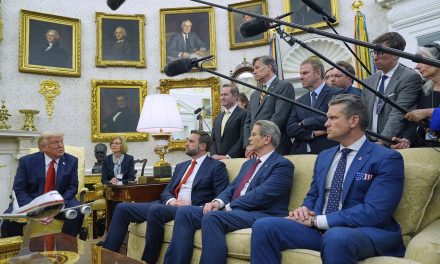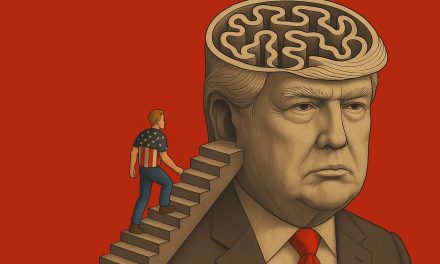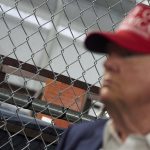
Imagine a man with a bullhorn standing in front of a school, shouting that giant spiders are abducting children from the playground. There is no evidence of any kind of spider, giant or otherwise, no missing children, and no eyewitnesses. But the claim is loud, repeated, and terrifying.
Within days, some parents demand action. The man with the bullhorn declares the need for urgent safety measures. He insists that playgrounds be reinforced with concrete and wire mesh. He demands that funding be allocated to combat this threat.
He drives the issue like a wedge between neighborhood parents, creating a polarized space between those demanding the eradication of all giant spiders and those calling for evidence that they exist and a thoughtful review of the alleged emergency.
After a sufficient period of turmoil, the man then holds a public stunt to step on a few daddy longlegs and calls this tough on giant spider campaign a sweeping victory. With cameras rolling, he proclaims: “We stopped the giant spiders.”
This scene of satire is a metaphor for how Donald Trump has repeatedly used false claims to shape public opinion, justify extreme actions, and declare self-serving victories, all while leaving the original lie intact.
From baseless voter fraud narratives to fearmongering about immigrants and false boasts about pandemic cures, Trump’s approach to political deception follows a well-worn path. Here is how that process typically unfolds. It is not an accident or fluke, but a deliberate strategy.
Experts in political communication and propaganda have documented similar patterns across authoritarian systems, but Trump has honed it into a uniquely American performance. These are the seven repeatable stages of what might be called the “Trump Lie Cycle.”
1. INVENT A THREAT
The first step is the fabrication of a crisis, an invented menace that evokes fear, anger, or disgust. It often involves some exaggerated version of a real concern: crime, disease, national decline. But the central element is false. Trump has claimed that voter fraud stole the 2020 election, that wind turbines cause cancer, that Muslims in New Jersey cheered during 9/11, and that millions of undocumented immigrants voted illegally. Each of these claims lacked credible evidence, yet they were delivered with certainty and repetition.
The lie is always bigger than life, it is massive, criminal, and urgent. Its size is part of its power. A small lie may be debunked. A big one forces people to argue on the liar’s terms, giving it oxygen.
2. AMPLIFY THE PANIC
After planting the falsehood, Trump escalates the volume. Through campaign rallies, interviews, social media posts, and subservient media outlets, the claim is repeated so often that it begins to feel familiar. To many, that familiarity signals truth. This is the “illusory truth effect,” a psychological phenomenon that has long been exploited in propaganda.
Trump also reinforces distrust in the institutions meant to challenge the lie. He paints the press as enemies of the people, calls government agencies part of a deep state, and accuses courts of bias. By discrediting outside verification, he turns himself into the sole trusted narrator.
3. DEMAND IMMEDIATE ACTION
The third stage is to push for extreme or urgent measures in response to the false crisis. If the lie was about giant spiders, the demand might be to shut down all playgrounds. In our reality, it is calls for mass deportations, election nullifications, military crackdowns, or surveillance expansion.
This tactic serves multiple goals. It demonstrates “leadership” to the base, forces lawmakers and officials into difficult positions, and creates the illusion that the crisis is being taken seriously. Trump frequently justifies harsh proposals as necessary reactions to the dangers he invented.
4. REDIRECT MONEY AND RESOURCES
Once the false crisis is accepted by supporters, Trump uses it to justify concrete reallocations of power or funding. This could mean diverting Pentagon funds to build a border wall, pressuring states to conduct sham election audits, or encouraging private donors to fund controversial legal battles.
The key feature is spectacle over substance. The resource shift need not solve any real problem, it only needs to appear bold. The real consequences include wasted tax dollars, broken institutions, or damage to civil norms.
5. STAGE SYMBOLIC VICTORIES
Trump rarely solves the invented crisis in a measurable way. Instead, he stages moments of theatrical success. These include press conferences in front of incomplete walls, token policy changes with no enforcement, or stunts like holding up a Bible in front of a church after protesters were violently cleared by military force.
In the case of giant spiders, he might crush a few harmless insects and declare the playground safe again. The spectacle becomes the substance.
6. DECLARE TOTAL VINDICATION
Once the symbolic victory is declared, Trump proclaims himself proven right all along, even if none of the original claims have been substantiated. He often recasts critics as bitter losers and reframes failures as successes. The absence of giant spiders becomes proof that his anti-spider campaign worked.
In reality, the lie was never real to begin with, but by this stage, that no longer matters. The victory narrative has taken root.
7. REPURPOSE THE LIE
Finally, even after the crisis fades, Trump often recycles the lie in new form. Old claims are reframed with fresh details or used to justify different policies. For example, after courts dismissed his voter fraud lawsuits, Trump continued to claim a rigged system. He then pushed for new voting restrictions or loyalty tests among GOP candidates.
Lies become modular. They evolve with the political moment.
This cycle has allowed Trump not only to shape media narratives but to weaponize misinformation as a governing tool. It does not matter if a claim is disproven. What matters is that it shifts attention, creates conflict, and forces others to respond on his terms. Over time, this produces exhaustion and confusion, both of which serve a leader who thrives on spectacle over substance.
The impact is not just political. For many Americans, the stress of navigating a constant stream of disinformation creates emotional and psychological fatigue. It fractures families, erodes shared reality, and deepens civic distrust. As the lies multiply, the cost becomes cultural.
Yet while the cycle is powerful, it is not unbreakable. There are clear strategies individuals can use to recognize and resist this pattern before it takes root.
HOW TO RECOGNIZE THE CYCLE OF LIES
The first step is awareness. Trump’s lies are not random. They follow a repeatable structure that can be learned and anticipated. If a dramatic claim emerges suddenly, especially through his partisan channels, ask whether there is verifiable evidence from neutral sources.
Does the claim rely on emotional shock rather than facts? Is it followed quickly by calls for extreme action?
Watch for the progression. A crisis is declared, a solution is demanded, and then a performance is staged. When this arc repeats across different topics, from immigration to public health, it becomes easier to see the manipulation.
HOW TO REDUCE STRESS AND DISINFORMATION FATIGUE
Once the pattern is recognized, the goal is not to refute every falsehood but to prevent it from controlling your attention. Here are several tactics supported by media literacy experts and psychologists:
- Stop amplifying false claims, even in rebuttal. Repeating the lie, even to dispute it, reinforces familiarity. Focus instead on sharing verified facts from credible sources.
- Name the tactic, not the content. Rather than saying, “That’s not true,” say, “This is a distraction,” or “This fits the same pattern we’ve seen before.” Reframing the conversation puts control back in the hands of the audience.
- Set personal information boundaries. Disinformation thrives on emotional burnout. Limit how much political content you consume daily, especially from reactive platforms like X or Facebook. Use browser extensions to filter known sources of manipulation.
- Strengthen shared reality. The best antidote to weaponized lies is trustworthy relationships. Talk to people in good faith, share reliable information calmly, and disengage from baited arguments. Lies need conflict to spread.
- Support structural reform. Individual actions help, but lasting resilience requires policy changes — stronger media literacy in schools, better content labeling by platforms, and accountability for repeated disinformation by public figures.
A LIE IN SERVICE OF POWER
The “giant spider” metaphor is absurd by design, but the emotional blueprint it describes is real, and still in use. When Trump claimed in 2020 that Democrats were using the pandemic to rig elections, the lie was not just about mail ballots. It was about delegitimizing defeat before it happened.
When he said in 2015 that Mexican immigrants were “bringing crime,” the lie was not about statistics. It was about creating a scapegoat.
In each case, the lies served a purpose. They presented Trump as the sole protector against a world full of threats, whether real or imagined. The costs were left for the public to absorb, in broken trust, wasted resources, and deepened divisions.
Understanding the life cycle of a Trump lie is not just about fact-checking the past. It is about inoculating against the future. The tactics will return, if not from Trump himself, then from those who studied his playbook. The best defense is a public that knows the script before it is performed.
© Photo
Cora Yalbrin (via ai@milwaukee)














